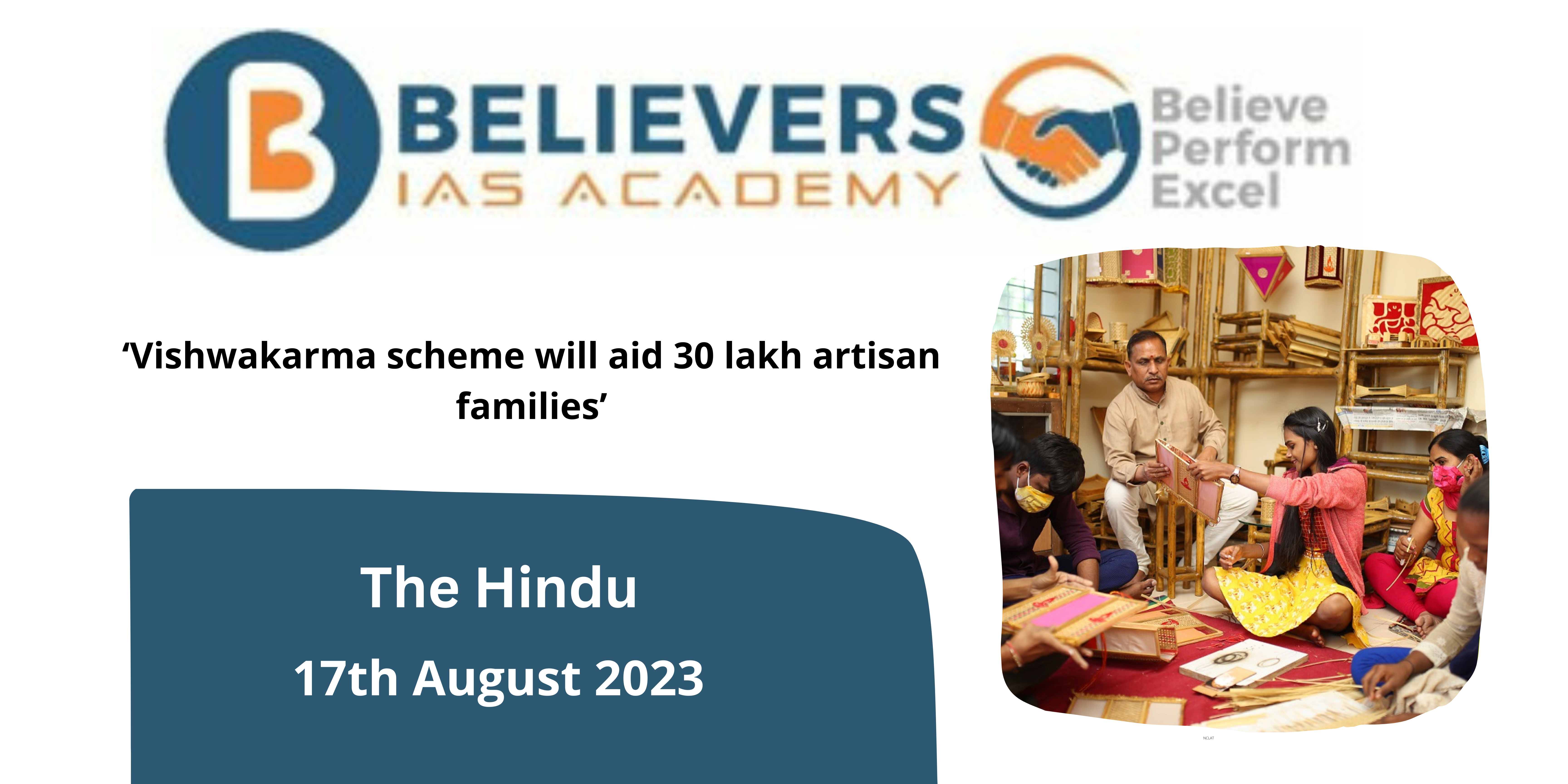‘Vishwakarma scheme will aid 30 lakh artisan families’
Context
The “PM Vishwakarma” scheme, which has a $13,000 crore budget, was approved by the Cabinet Committee on Economic Affairs (CCEA) on Wednesday. The program, which Prime Minister Narendra Modi announced during his speech on Independence Day, would be open to traditional artisans and crafters from 2023–2027.
What is PM Vishwakarma Scheme?
- The Cabinet Committee on Economic Affairs gave its blessing to the “PM Vishwakarma” scheme, an Indian government project with a $13,000 crore budget. The availability of this program, which Prime Minister Narendra Modi announced during his Independence Day speech, is scheduled to run from 2023–2027.
- Through the “Guru-Shishya parampara” or the traditional teacher-student relationship, the scheme’s primary goal is to support and foster the traditional skills and crafts used by artists and craftspeople. It strives to improve and maintain the family-based practice of age-old trades that require using hands and tools.
What are the features of the scheme?
- Objective and Focus: The program’s main objective is to support and advance the traditional trades that craftsmen and craftspeople engage in. The “Guru-Shishya parampara” (teacher-student tradition) and family-based practice of ancient skills are its key focuses.
- Financial Allocation: The plan has a $13,000 crore total outlay, which is the budget allotted for its execution over a given time frame.
- Time Frame: The program is scheduled to be offered for a specified amount of time, beginning in 2023–2024 and lasting until 2027–2028.
- Beneficiary Coverage: The program provides benefits to workers in 18 traditional trades, including carpenters, blacksmiths, potters, goldsmiths, tailors, and others.
- Quality Improvement: Enhancing the quality of the goods and services produced by artisans is one of the program’s goals. This entails promoting higher standards, better craftsmanship, and higher-quality goods.
- Market Reach: Another goal of the program is to increase the market reach of artisan-made goods and services. This entails enhancing traditional crafts’ visibility in both domestic and international markets.
- Value Chain integration: Integrating craftsmen and crafters into domestic and international value chains is the goal of the program. To do this, they must be linked to broader supply chains and markets, which may result in more lucrative business opportunities.
- Certification: Beneficiaries will be issued a PM Vishwakarma certificate and identification card, confirming their identity as traditional artisans under the program.
- Credit Support: Access to credit support will be available to artisans and crafters. They are eligible for loans in two instalments, with the first offering up to 1 lakh and the second offering up to 2 lahks. These loans will have an introductory interest rate of 5%.
- Skill Development: The plan covers both basic and advanced skill development programs. Beneficiaries will receive skill development so they can become more knowledgeable and skilled in their particular crafts.
- Stipend during Training: Beneficiaries will be paid a stipend of 500 per day while undertaking skill training. This stipend intends to give artists financial assistance while they are in training.
What are the goals that the scheme intends to tackle?
- Improved Quality and Reach: The program aims to improve the goods and services produced by artists and craftspeople in terms of both quality and reach. It seeks to guarantee that the goods are more marketable and of greater quality.
- Integration with Value Chains: The program aims to incorporate local and international value chains for craftsmen and craftspeople. This entails linking them to bigger marketplaces and supply networks so they can take advantage of more opportunities.

Which are the trades that come under this Scheme?
The scheme covers a range of 18 traditional trades, including:
- Carpenter
- Boat maker
- Armourer
- Blacksmith
- Hammer and tool kit maker
- Locksmith
- Goldsmith
- Potter
- Sculptor
- Stone breaker
- Cobbler
- Mason
- Basket/mat/broom maker/coir weaver
- Traditional doll and toy maker
- Barber
- Garland maker
- Washerman
- Tailor
- Fishing net maker
Conclusion
The government’s efforts to promote traditional artists and craftspeople, develop their abilities, and incorporate them into the greater economic environment are included in this initiative. The promotion of historic knowledge and skills while simultaneously linking them to contemporary economic prospects is consistent with the goal of the prime minister.




